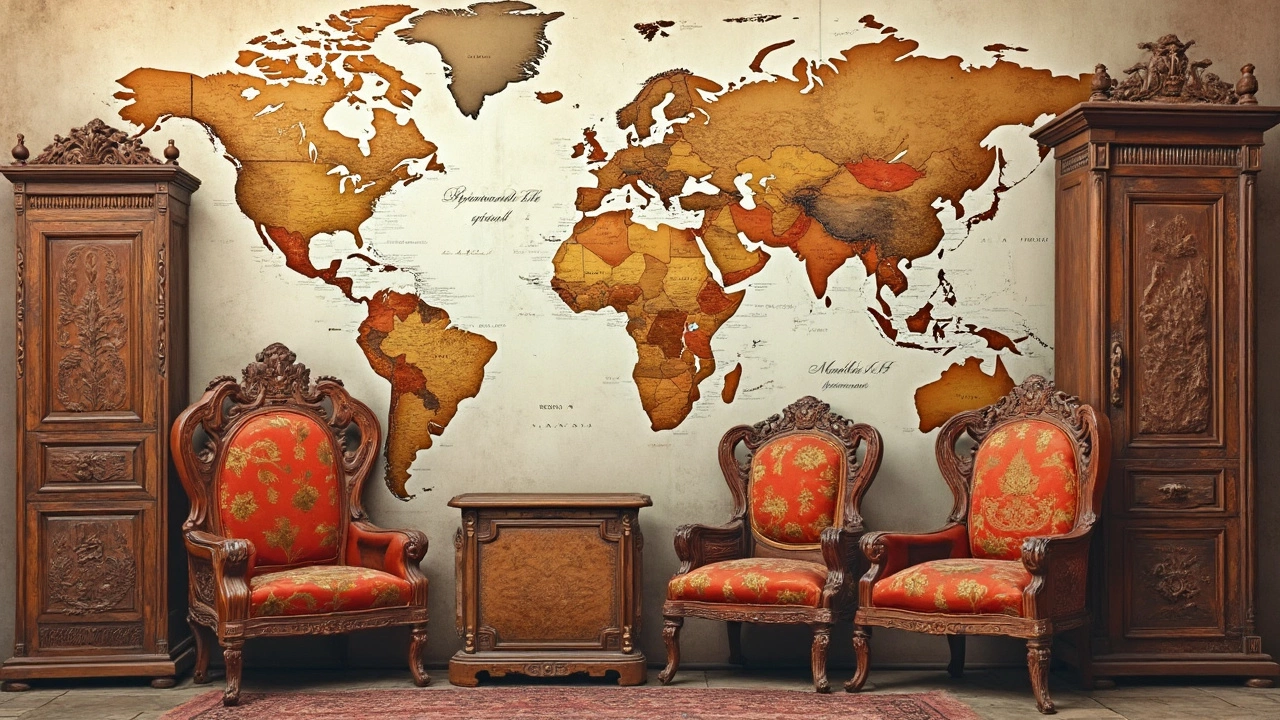So, you've fallen in love with the exquisite designs of Indian furniture and you're thinking, can you actually ship that stunning teak table from India to your cozy home in the USA? The good news? Yes, you absolutely can! But, like all good things, there are steps and considerations involved.
First off, why go through all the hassle of importing Indian furniture? Simple. India is known for its craftsmanship and unique designs that can add a touch of elegance and warmth to any home. Whether it’s intricate carved pieces or modern minimalist designs, Indian furniture offers something for every taste and style.
However, before you get too excited and start buying up a storm, you need to know about the import regulations. Countries have specific rules about bringing in goods, and furniture is no exception. You'll need to familiarize yourself with customs duties, necessary documentation, and any restrictions that might apply to certain types of wood.
- Why Import Indian Furniture?
- Understanding Import Regulations
- Choosing the Right Shipping Method
- Costs and Considerations
- Tips for a Hassle-Free Experience
Why Import Indian Furniture?
Indian furniture is more than just a functional piece; it's a statement. It's known for its exquisite craftsmanship, intricate detailing, and use of high-quality materials like teak, sheesham, and mango wood. These are not just durable, but they also age beautifully, adding character to your space over time.
One of the compelling reasons to consider importing Indian furniture is the variety it offers. From traditional carved designs that tell stories of ancient Indian culture to sleek modern styles, there's something for everyone. They seamlessly blend into different home aesthetics, whether you’re going for a vintage vibe or a contemporary look.
Affordability is another bonus. Even when you account for shipping and import fees, you might find that importing directly can be cheaper than buying similar quality items locally. Plus, who doesn't love having something unique that prompts admiration and maybe just a little envy from your guests?
For those who value sustainability, many Indian manufacturers focus on eco-friendly practices. They use traditional techniques that minimize waste and often source wood responsibly. Plus, having handcrafted pieces means supporting local artisans and preserving their skills for future generations.
Lastly, Indian furniture adds a multicultural element to your home. It's a way to introduce diverse textures and colors, making your space not just a place to live, but a reflection of global appreciation and personal taste.
Indian furniture isn’t just about filling a room; it's about enhancing it with stories and cultures from across the world, turning your house into a home with history and heart.
Understanding Import Regulations
Navigating the world of furniture import from India to the USA can seem overwhelming at first, but once you get the hang of the rules, it’s pretty straightforward. First, let's tackle the paperwork. You’ll need to fill out a Customs Declaration Form, which is crucial for ensuring your goods enter the USA without a hitch.
Now, here's where things get a bit technical. The U.S. Customs and Border Protection (CBP) has specific rules about what can come into the country. For example, wooden furniture needs to be pest-free, which means it often has to undergo treatment. The CBP states,
All wood products entering the USA must comply with regulations designed to prevent the introduction of harmful pests.Keeping this in mind will save you delays and unwanted surprise inspections.
Also, be aware of the Harmonized Tariff Schedule (HTS). This is basically a list that tells you the duties on the furniture you’re importing. Hidden costs can add up quickly if you’re not careful!
There are a few key things to remember:
- Check the HTS code for your furniture import to understand duties and taxes.
- Ensure the wood furniture complies with pest treatment regulations.
- Have all the necessary documentation ready before you ship.
So, while it might sound like a lot, understanding these import regulations is just about preparation. Following these guidelines will make sure that stunning Indian furniture lands smoothly in your living room without a hassle.

Choosing the Right Shipping Method
Transporting your cherished Indian furniture across the globe might sound like an epic journey—think of it as the furniture's adventure from the mystical lanes of Jaipur to your front door in California. To start with, you need to pick the right shipping method to ensure your furniture arrives safely and without hiccups.
One of the first things to consider is whether to opt for air freight or sea freight. Air freight is speedy but can cost a pretty penny, especially if you're shipping several big items. On the other hand, sea freight is your go-to for weighty loads and will often be more budget-friendly despite the longer waiting period.
Next, you’ll decide between different types of sea freight containers. LCL (Less than Container Load) might suit you if you’re not importing in bulk, offering shared container space. But if you’ve splurged on a whole house worth of furniture, FCL (Full Container Load) will be your best bet. This choice ensures your cargo stays together and reduces handling.
"Choosing the right shipping method isn't just about cost, it's about value, security, and peace of mind," says logistics expert Priya Desai.
You might want to ask your furniture vendor about their trusted shipping partners; they often have established relationships with reliable logistics companies. Also, check if they offer any special packing services that enhance protection—think bubble wrap, custom crate building, you name it!
Finally, a few pro-tips: Check your furniture's measurements and weight before deciding on the method. Some companies provide online calculators that help you estimate costs, making it easier to budget accurately. Double-check insurance options, too—you’re not just dealing with furniture but precious assets and long-distance travel throws curveballs.
- Determine if air freight or sea freight suits your timeline and budget.
- Choose between LCL or FCL based on your volume.
- Verify if your vendor has reliable shipping contacts.
- Consider shipping insurance to protect against loss or damage.
- Always measure and weigh your furniture beforehand for accurate cost estimates.
Costs and Considerations
Alright, so you're serious about bringing furniture from India to the USA. Let’s break down what it's going to cost you and some other things you should think about.
First up, shipping costs. These can vary a ton depending on the size and weight of your items, and whether you choose air or sea freight. If you're in a hurry, air freight is faster but will put a bigger dent in your wallet. Ocean shipping can be cheaper, but it means waiting several weeks for your furniture to make the journey.
Next, don't forget about import duties and taxes. The U.S. has tariffs on various goods, and imported furniture will definitely attract these duties. Typically, import duty rates for furniture are between 0-10%, but this can change, so make sure you’ve checked the latest figures.
Let’s talk packaging. You want to ensure your valued Indian furniture gets to the U.S. in one piece. Secure packaging is essential. This means working with a reliable company in India that understands how to package your items properly for long-distance transport.
There are also hidden costs like documentation fees, insurance, and potential storage charges if there are any delays in shipping. Insurance might seem like an unnecessary expense, but with delicate and high-value items, it’s a precaution worth taking.
Here's a quick breakdown:
- Shipping Costs: Depends on method and volume.
- Import Duties and Taxes: Usually 0-10%, varies.
- Packaging: Essential for safe arrival.
- Insurance: Optional but recommended.
- Handling Fees: Custom documentation and potential storage.
Make sure to get quotes from different shipping companies and compare. You’d be surprised at how much rates can vary.
Lastly, always budget for unexpected expenses. Stuff happens—whether it's a customs delay or an insurance hiccup, having a little extra set aside can save you a big headache.

Tips for a Hassle-Free Experience
Bringing furniture over from India to the USA doesn't need to be a headache. With a bit of preparation, you can make the process smoother. Here are some tips to help you along the way.
First and foremost, do your homework on international shipping companies. They aren't all created equal, and some have more experience with shipping furniture than others. Look for companies that offer door-to-door services, as they'll handle everything from picking up your pieces in India to delivering them to your doorstep in the USA.
Next, think about insurance. This might seem like an added expense, but when you're moving valuable Indian furniture, it's better to be safe than sorry. Policies vary, so check what each company offers and what’s covered in case something goes wrong during transit.
It also helps to pack your items properly. This might sound like a no-brainer, but you'd be surprised how often items get damaged because they weren’t packed right. Use quality packing materials and, if you can, hire professionals to take care of this part.
When figuring out logistics, timing is everything. Make sure you’re aware of the shipping timelines. Most sea shipments can take several weeks, so plan accordingly if you need your furniture by a certain date.
And let's not forget about customs. Paperwork, taxes, and duties can be confusing, so it’s worth talking to a customs broker. They know the ins and outs and will ensure your furniture sails through the process without any hiccups.
Lastly, don’t underestimate the power of reviews. Online reviews from people who have recently imported furniture from India to the USA can offer valuable insights. They might even recommend certain companies or share pitfalls to avoid.
Keep these tips in mind, and you'll have an easier time getting your Indian treasures into your American abode. Happy importing!
